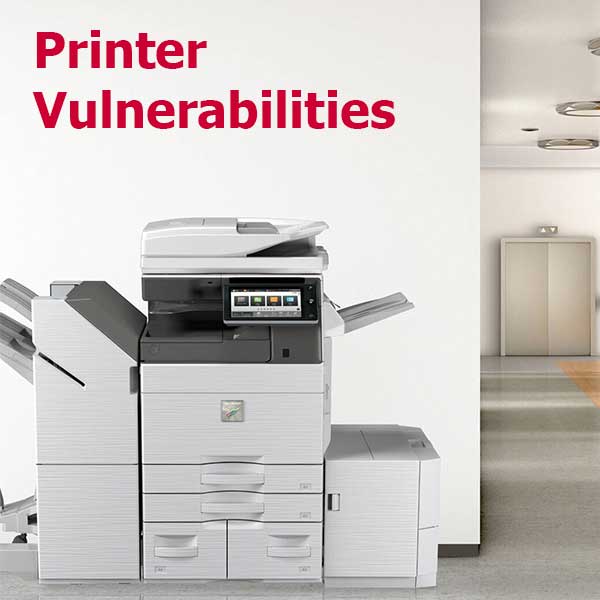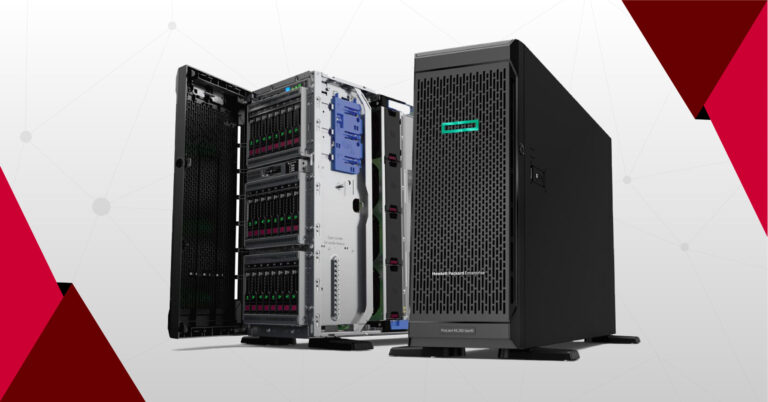Printer Vulnerability
Multifunction printers (MFPs) are pivotal tools within contemporary offices, optimizing diverse operations. However, acknowledging the security vulnerabilities linked to these devices is crucial. Cyber threats persist as hackers relentlessly seek weaknesses to exploit. Strengthening your office’s defenses necessitates thoroughly understanding prevalent attack techniques and implementing robust security measures. Safeguarding your organization’s data transcends conventional defenses like firewalls and antivirus software in the ever-evolving cybersecurity landscape. Printer security stands as a commonly disregarded facet. This article explores printer cybersecurity risks that may affect your business or organization to help you identify potential threats.
Printers serve as Entry Points for Malware Attacks
Many companies spend significantly to curb cyberthreats to their business. However, many businesses need to pay more attention to their printers regarding electronic security. Hackers exploit printer vulnerabilities to install malicious software, exposing the entire office network. Through printer vulnerabilities, hackers inject malware throughout a company’s network to other devices, disrupting operations, stealing sensitive data, and launching further attacks even on third-party partnership companies. Because companies pay such low attention to the hidden risks of printer security, hackers target printers to gain access to network systems.

How Pervasive Are Printer Cybersecurity Hacks?
Printer cybersecurity hacks are a concern and pose significant risks within various organizations and industries. Several factors impact the pervasiveness of printer-related cyber attacks. While specific statistics might vary, reports from cybersecurity firms and incidents reported by organizations worldwide underscore the growing threat of printer cybersecurity hacks.
Vulnerable Printer Security Risk Statistics and Facts
Data Loss
According to QuoCirca, 61% of organizations experienced print-related data loss over the past year.1
Cyberthreat Vulnerability
A 2021 hacking contest found that over 200 printer models from a single brand are vulnerable to cyberthreats.2
Unsecured Printers
Cybernews hijacked nearly 28,000 unsecured printers worldwide and forced them to print out a guide on printer security.3
FBI Warnings
The FBI issued warnings about cybercriminals targeting printers, door locks, smart TVs, and more advising organizations to secure these devices to prevent attacks.4
Cybersecurity Emergency Directives
Cybersecurity & Infrastructure Security Agency (CISA) issued Emergency Directive (ED) 21-04 regarding print spooler service vulnerability. The ED indicates that cyberattacks can exploit this vulnerability to remotely execute code to compromise the entire infrastructure of a targeted organization quickly.5
Military Cybersecurity Risks
The U.S. military purchased over $32m of security risk electronics, including printers and computers.6

List of Printer Vulnerabilities and Network Cybersecurity Risks
Default Passwords: Strengthening Access Control
Default passwords are a glaring vulnerability. MFPs often come with easily guessable or publicly available default credentials. If unchanged, these passwords grant unauthorized access to crucial printer settings. Immediately change the default password to a strong, unique one to eliminate this risk. Additionally, consider configuring devices with Active Directory user authentication. This approach enhances control, restricting access based on user roles and ensuring trusted network interactions.
Unsecured Network Connections: Fortifying Your Digital Perimeter
Multifunction Printers (MFPs) act as network terminals, rendering them vulnerable to a range of cyber threats. Unsecured network connections create openings for Denial-of-Service (DoS) attacks, phishing endeavors, and malware infiltration. Safeguard your network by utilizing secure connections like WPA2. Enhance native security by incorporating firewalls and advanced security measures such as Bitdefender antivirus protection to fortify defenses and deter malicious software.
Outdated Firmware: Safeguarding Against Exploits
Neglecting firmware updates leaves MFPs vulnerable to attacks. Manufacturers release updates to address security flaws, making timely installations crucial. Automate firmware updates whenever possible. Certain devices, like Sharp BP Series MFPs, offer automated firmware checks and restoration features, ensuring seamless protection without manual intervention.
Unsecured Print Jobs: Preserving Data Confidentiality
Print jobs often contain sensitive information, making secure print release protocols vital. Implement security measures such as PIN codes, ID cards, or encryption to authenticate users before printing. Utilize Near Field Communication (NFC) Printing or Synnapx Go for wireless, secure document transmission and printing from mobile devices.
Unsecured Remote Access: Enhancing Connectivity Security
Remote printer access enhances convenience but demands stringent security measures. Safeguard remote access points using Virtual Private Networks (VPNs) or SSL connections. Leverage IT expertise to manage, monitor, and configure MFPs centrally. Tools like Sharp Remote Device Management (SRDM) empower administrators to enforce security policies, ensuring consistent protection and swift response to detected changes.
Unauthorized Network Access
Printers, especially network-connected ones, can be vulnerable to unauthorized access. If not properly secured, attackers might exploit this vulnerability to access sensitive documents or use the printer as a gateway to infiltrate the broader network.
Network Data Breaches
Printers store copies of documents in their memory, which, if not encrypted or regularly purged, can be accessed by unauthorized individuals. Unsecured print jobs or unclaimed printouts on the printer tray can lead to a data breach.
Malware and Ransomware Attacks
Like any networked device, printers are susceptible to malware and ransomware attacks. Hackers might use these attacks to disrupt printing operations, steal sensitive data, or demand ransom payments to release control of the printer.
Physical Security Risks
Physical access to printers can pose a threat if printers are in unsecured areas. Unauthorized individuals accessing the printer might retrieve printed documents containing sensitive information.
Firmware Vulnerabilities
Outdated firmware in printers can harbor vulnerabilities that hackers can exploit to gain control of the device, execute malicious code, or manipulate printer settings.
Unsecured Configuration Settings
Improperly configured settings, default passwords, or weak authentication mechanisms can make printers an easy target for cyber attackers, allowing them to access, manipulate, or intercept print jobs.
Lack of Encryption
Printers often transmit data across networks without encryption. This lack of encryption can lead to intercepted print jobs containing sensitive information, increasing the risk of data breaches.
Lack of Regular Updates and Patches
Failure to update printer firmware and software with the latest security patches can leave devices vulnerable to known vulnerabilities that attackers could exploit.
Print Job Interception
Print jobs sent over a network can be intercepted and manipulated by attackers, leading to unauthorized access to sensitive information or the injection of malicious content into printed documents.
Insufficient User Awareness
Lack of awareness among employees about printer security best practices can lead to inadvertent security breaches, such as leaving sensitive documents unattended on the printer tray or failing to secure access to the printer. See Printer Data Security Features and Top Rated Cybersecurity Printers for more information. You may also be interested in a Comprehensive Guide for Printer Security.

Summary
In today’s vulnerable landscape, MFPs are often overlooked entry points for cybercriminals. Understanding these vulnerabilities and proactively securing your devices will fortify your office environment against potential threats. Addressing these security risks requires a comprehensive approach that includes implementing proper access controls, regularly updating firmware and software, encrypting sensitive data, enforcing secure configuration settings, providing employee training on security best practices, and maintaining physical security measures around printers. Click the following link to dive into the Best Practices for Printer Security.
Assess your organization’s security stance with our Aberdeen-driven Printer Security Assessment to ensure you remain ahead of the curve in print and cybersecurity. Stay secure, stay ahead.
Footnotes
- 1 Print Security Landscape, 2023. QuoCirca. April, 2023. Accessed 13 Sep 2023. quocirca.com/wp-content/uploads/2023/04/Quocirca-Print-Security-Landscape-Infographic-2023.pdf.
- 2 Arghire, Ionut. Serious Vulnerability Exploited at Hacking Contest Impacts Over 200 HP Printers. SecurityWeek. March 24, 2022. Accessed 14 Sep 2023. www.securityweek.com/serious-vulnerability-exploited-hacking-contest-impacts-over-200-hp-printers/.
- 3 We hijacked 28,000 unsecured printers to raise awareness of printer security issues. Cybernews. October 7, 2022. Accessed 14 Sep 2023. cybernews.com/security/we-hacked-28000-unsecured-printers-to-raise-awareness-of-printer-security-issues/.
- 4 Cyber Tip: Be Vigilant with Your Internet of Things (IoT) Devices. Federal Bureau of Investigation. October 13, 2015. Accessed 14 Sep 2023. www.fbi.gov/news/stories/cyber-tip-be-vigilant-with-your-internet-of-things-iot-devices.
- 5 ED 21-04: Mitigate Windows Print Spooler Service Vulnerability. Official Alerts & Statements, Cybersecurity & Infrastructure Security Agency. July 13, 2021. Accessed 14 Sep 2023. www.cisa.gov/stopransomware/official-alerts-statements-cisa.
- 6 Cimpanu, Catalin. US military purchased $32.8m worth of electronics with known security risks. ZDNET. August 4, 2019. Accessed 14 Sep 2023. www.zdnet.com/article/us-military-purchased-32-8m-worth-of-electronics-with-known-security-risks/





